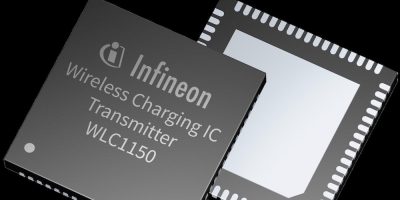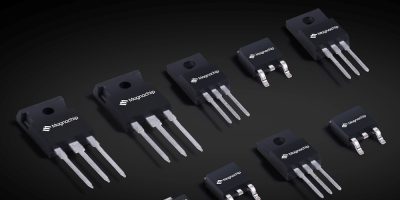Infineon Technologies has extended its portfolio of wireless charging controller ICs, adding the WLC1150 which supports up to 50W applications.
The wireless charging controller ICs are designed for applications requiring higher wireless power transfer, for example industrial applications, healthcare equipment, robotics and drones, vacuum cleaners, power tools, docking stations, and smartphone chargers supporting the Qi Extended Power Profile (EPP).
The WLC1150 transmitter is designed to provide high efficiency, flexible thermal management options, low electromagnetic interference (EMI), integrated adaptive foreign object detection (FOD) and inverter control. It uses multiple methods to tune the adaptive FOD, including Q-factor, resonant frequency and power.
The transmitter supports 50W wireless power transfer using a high power proprietary charging protocol and a wide input voltage range of 4.5 to 24V. The integrated fan buck controller enables thermal management by cooling the interface surface during high power delivery. It also includes integrated gate drivers for the inverter, which is controlled by frequency, duty cycle and variable voltage.
It also integrates a USB type-C power delivery (PD) controller that supports the latest version of USB-PD 3.1 with programmable power supply (PPS) mode. The WLC1150 complies with the WPC Qi 1.3 with EPP, basic power profile (BPP), and proprietary power delivery extension (PPDE). It supports systems with input power supplied from either USB PD / PPS or fixed input from a DC power supply. With either input configuration, the transmitter does not require a front-end DC/DC converter. This helps to significantly improve system efficiency, confirmed Infineon.
Adjustable over-voltage protection (OVP), over-current protection (OCP), and over-temperature protection (OTP) are also supported. The WLC1150 transmitter IC can be paired with the upcoming WLC1250 receiver IC to realise end-to-end proprietary wireless power transfer solutions, Infineon advised.
The WLC1150 is based on a programmable 32-bit Arm Cortex-M0 processor equipped with 128kbyte flash, 16kbyte RAM and various peripherals such as ADC, PWMs and timers. Its full-stack firmware is configurable to allow customisation of application-specific FOD, in-band communication, sensing, protection and other system parameters. This is made possible by a GUI (graphical user interface) that eliminates the need for code debugging and streamlines the configuration process. Combined with Infineon’s ModusToolbox, the WLC1150’s programmable features enable users to develop scalable wireless charging for proprietary protocols as well as the latest Qi specification.
The IC WLC1150 integrated wireless charging transmitter for high power applications is available in a 68 pin 8.0 x 8.0mm² in tray, as well as tape and reel packages. It is available for order now.
The WLC1150 will be showcased at PCIM Europe 2023 (09 to 11 May) in Nuremberg, Germany, at Infineon’s stand in Hall 7 (7-412).






